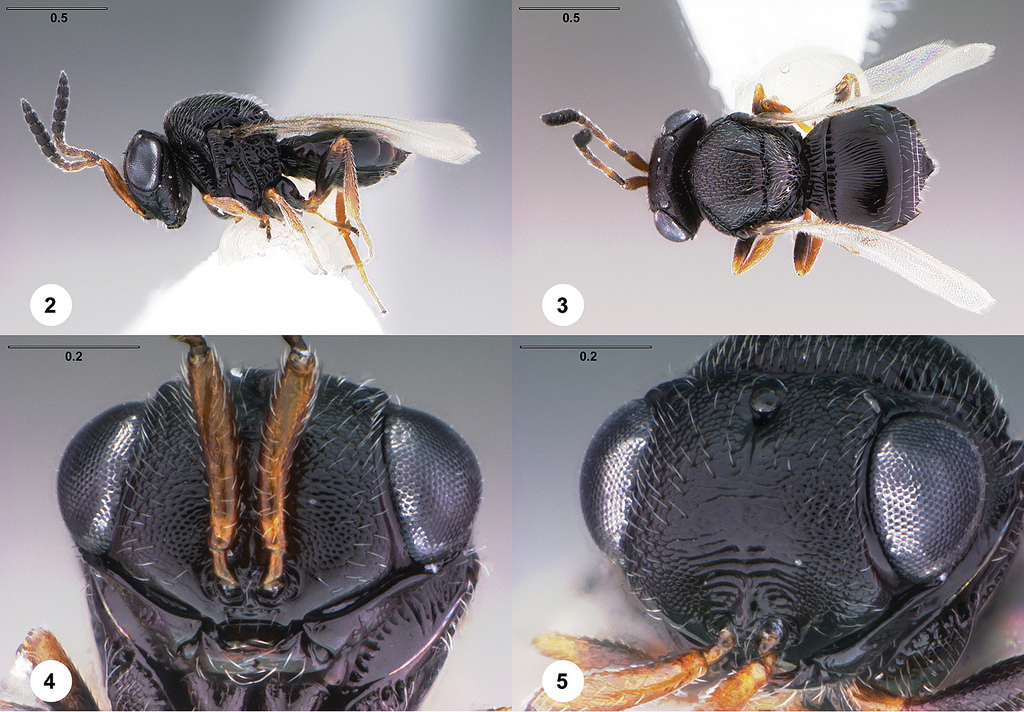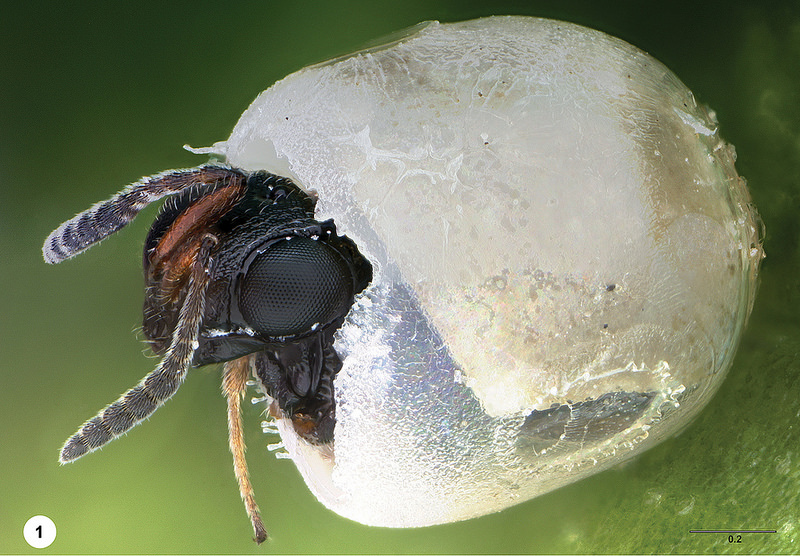Map Snapshot


4 Records
Status
"Trissolcus japonicus is native to China, Japan, and South Korea, where the brown marmorated stink bug is native. Adventive, wild populations of Trissolcus japonicus were discovered in Beltsville, Maryland in 2014 (Talamas et al., 2015), at several additional nearby sites in Maryland, Washington, D.C. and in Winchester, Virginia during 2015 (Jentsch, 2015: unpublished survey data) and in Vancouver, Washington in August 2015 (Milnes et al., 2016). It is speculated that these wild populations of Trissolcus japonicus may have arrived within stink bug egg masses on plant cargo shipped from Asia. ... Females chemically mark the egg in which they oviposit and will defend the egg clutch against other rival parasitoids. Males will commonly emerge first, wait atop the egg mass for the female to emerge, and then mate with females as they emerge" (Neal, 2016).
"Since 2014, the samurai wasp has turned up in 10 states and Washington, D.C. Researchers have identified at least three genetically distinct strains, suggesting multiple introductions" (Servick, 2018).
"Detection of T. japonicus in wooded habitat in the United States is concerning for two reasons and warrants further investigation. First, although T. japonicus could decrease the population of H. halys overall, this parasitoid was not found in the soybean field habitat in which H. halys can be abundant and damaging during the late summer. Second, it has been shown in the laboratory that T. japonicus readily and successfully parasitizes eggs of native beneficial stink bugs including the Spined Soldier Bug, Podisus maculiventris, which is an important predator of both native and invasive pests such as Mexican Bean Beetle (Epilachna varivestis), Colorado Potato Beetle (Leptinotarsa decemlineata), Cabbage Looper (Trichoplusia ni), and Gypsy Moth (Lymantria dispar). Given that woody habitats are preferred for overwintering and in the early season by P. maculiventris, and that our wooded site is the only one where T. japonicus was detected, this poses non-target concerns and will be explored in more detail in future field studies" (Herlihy et al., 2016).
Description
About the size of a sesame seed.
Relationships
The Samurai Wasp is an egg parasitoid of the Brown Marmorated Stink Bug.
Seasonality Snapshot
Source: Wikipedia
| Trissolcus japonicus | |
|---|---|

| |
| Scientific classification | |
| Domain: | Eukaryota |
| Kingdom: | Animalia |
| Phylum: | Arthropoda |
| Class: | Insecta |
| Order: | Hymenoptera |
| Family: | Scelionidae |
| Genus: | Trissolcus |
| Species: | T. japonicus
|
| Binomial name | |
| Trissolcus japonicus (Ashmead, 1904)
| |
| Synonyms[1] | |
|
Trissolcus halyomorphae Yang et al, 2009 | |
Trissolcus japonicus, the samurai wasp, is a parasitoid wasp species in the family Scelionidae, native to east Asia but now found in Europe, North America, and Chile.[2][3] It is chiefly known for parasitizing Halyomorpha halys (brown marmorated stink bug).[4] It deposits eggs into the eggs of the stink bug, and as the wasp larvae develop, they kill the stink bug eggs. A single adult wasp emerges from each stink bug egg.[5]
Taxonomy
[edit]Trissolcus japonicus was originally described by American entomologist William Harris Ashmead in 1904,[6] and transferred to the genus Trissolcus in 1968.[7] All species within the genus Trissolcus are egg parasitoids of Pentatomoidea (stink bugs and their allies).[8] Trissolcus halyomorphae was in use from 2009, but has since been classified as a junior synonym of Trissolcus japonicus.[9][10]


Description
[edit]Adults of this species are small black wasps with orange and black legs and antennae. The adult samurai wasp is 1–2 millimetres (3⁄64–5⁄64 in) in length. The size of the wasp depends on the size of the host egg from which it emerged.[11] It does not sting people.[12]
Distribution
[edit]The samurai wasp is native to Eastern Asia, including China, Japan, Korea, and Taiwan.[13]
In 2014, two adventive populations were found in the United States during surveys to identify which North American parasitoids might be attacking brown marmorated stink bug.[2][14] Subsequent genetic testing showed these wild populations were self-introduced: they were not related to each other, or to the laboratory strain of parasitoids housed in quarantine for biosafety testing since 2007.[15] An adventive European population was discovered during similar surveys in Switzerland in 2017.[16]
Biological control
[edit]Trissolcus japonicus is currently the subject of biological control programs against the brown marmorated stink bug (BMSB) in the US, Europe, and New Zealand.[17] In the United States, it will likely take years for the wasps to build up large enough densities in the wild to have a measurable impact on BMSB populations, but efforts are under way to augment wild populations with laboratory reared specimens.[18][19] Recent redistribution efforts of T. japonicus in New York State also engages citizen science project participants in reducing urban BMSB populations.[20] In New Zealand, host range testing has shown it attacks the endemic alpine shield bug (Hypsithocus hudsonae) in laboratory tests when a parasitoid is confined with an egg mass.[21]
Life cycle
[edit]In its native range, the samurai wasp is able to complete up to 10 generations per year, while its primary host, brown marmorated stink bug, completes up to 2.[13] Female wasps lay on average 42 eggs, preferring to oviposit into host eggs younger than 3 days old. Males hatch first and mate with their sisters.[22]
References
[edit]- ^ Talamas, Elijah J.; Buffington, Matthew; Hoelmer, Kim (2013-08-01). "New synonymy of Trissolcus halyomorphae Yang". Journal of Hymenoptera Research. 33: 113–117. doi:10.3897/jhr.33.5627.
- ^ a b Talamas, Elijah J.; Herlihy, Megan V.; Dieckhoff, Christine; Hoelmer, Kim A.; Buffington, Matthew; Bon, Marie-Claude; Weber, Donald C. (2015). "Trissolcus japonicus (Ashmead) (Hymenoptera, Scelionidae) emerges in North America". Journal of Hymenoptera Research. 43: 119–128. doi:10.3897/jhr.43.4661. ISSN 1314-2607.
- ^ Leskey, Tracy C.; Nielsen, Anne L. (2018-01-07). "Impact of the Invasive Brown Marmorated Stink Bug in North America and Europe: History, Biology, Ecology, and Management". Annual Review of Entomology. 63 (1): 599–618. doi:10.1146/annurev-ento-020117-043226. ISSN 0066-4170. PMID 29068708. S2CID 207595756.
- ^ Pfeiffer, Douglas G. (March 30, 2009). "Brown Marmorated Stink Bug". Virginia Tech Department of Entomology. Retrieved January 10, 2013.
- ^ "Trissolcus halyomorphae". Oregon State University Department of Horticulture. Archived from the original on April 7, 2014. Retrieved January 10, 2012.
- ^ Ashmead, William Harris (1904). "Descriptions of new Hymenoptera from Japan – I". Journal of the New York Entomological Society. 12: 65–84.
- ^ Masner, Lubomir; Muesebeck, Carl F. W. (1968). "The Types of Proctotrupoidea (Hymenoptera) in the United States National Museum". Bulletin of the United States National Museum (270): 1–143. doi:10.5479/si.03629236.270. hdl:10088/10144.
- ^ Johnson, Norman F. (1984). "Revision of the Nearctic species of the Trissolcus flavipes group (Hymenoptera: Scelionidae)". Proceedings of the Entomological Society of Washington. 86: 797–807. Archived from the original on 2018-11-29. Retrieved 2018-11-29.
- ^ Talamas, Elijah; Buffington, Matthew; Hoelmer, Kim (2013). "New synonymy of Trissolcus halyomorphae Yang". Journal of Hymenoptera Research. 33: 113–117. doi:10.3897/jhr.33.5627. ISSN 1314-2607.
- ^ Rice, Kevin B.; Bergh, Chris J.; Bergmann, Erik J.; Biddinger, Dave J.; Dieckhoff, Christine; Dively, Galen; Fraser, Hannah; Gariepy, Tara; Hamilton, George (2014). "Biology, Ecology, and Management of Brown Marmorated Stink Bug (Hemiptera: Pentatomidae)". Journal of Integrated Pest Management. 5 (3): 1–13. doi:10.1603/ipm14002. hdl:10919/73730. ISSN 2155-7470.
- ^ "common name: Samurai wasp; scientific name: Trissolcus japonicus (Ashmead) (Insecta: Hymenoptera: Scelionidae: Telenominae)". entnemdept.ufl.edu.
- ^ "7 Things to know about samurai wasps, a natural enemy of brown marmorated stink bugs". Department of Entomology. 3 November 2019.
- ^ a b Yang, Zhong-Qi; Yao, Yan-Xia; Qiu, Lan-Fen; Li, Zhong-Xin (2009). "A New Species of Trissolcus (Hymenoptera: Scelionidae) Parasitizing Eggs of Halyomorpha halys (Heteroptera: Pentatomidae) in China with Comments on Its Biology". Annals of the Entomological Society of America. 102 (1): 39–47. doi:10.1603/008.102.0104. ISSN 0013-8746. S2CID 55288032.
- ^ Herlihy, Megan V.; Talamas, Elijah J.; Weber, Donald C. (2016). "Attack and Success of Native and Exotic Parasitoids on Eggs of Halyomorpha halys in Three Maryland Habitats". PLOS ONE. 11 (3): e0150275. Bibcode:2016PLoSO..1150275H. doi:10.1371/journal.pone.0150275. ISSN 1932-6203. PMC 4794195. PMID 26983012.
- ^ Milnes, Joshua M.; Wiman, Nik G.; Talamas, Elijah J.; Brunner, Jay F.; Hoelmer, Kim A.; Buffington, Matthew L.; Beers, Elizabeth H. (2016). "Discovery of an Exotic Egg Parasitoid of the Brown Marmorated Stink Bug, Halyomorpha halys (Stål) in the Pacific Northwest". Proceedings of the Entomological Society of Washington. 118 (3): 466–470. doi:10.4289/0013-8797.118.3.466. ISSN 0013-8797. S2CID 89561247.
- ^ Stahl, Judith; Tortorici, Francesco; Pontini, Marianna; Bon, Marie-Claude; Hoelmer, Kim; Marazzi, Cristina; Tavella, Luciana; Haye, Tim (2018). "First discovery of adventive populations of Trissolcus japonicus in Europe". Journal of Pest Science. 92 (2): 371–379. doi:10.1007/s10340-018-1061-2. hdl:2318/1685812. ISSN 1612-4758.
- ^ Charles, J. G.; Avila, G. A.; Hoelmer, Kim A.; Hunt, Sophie; Gardner-Gee, Robin; MacDonald, Frances; Davis, Vicky (August 2019). "Experimental assessment of the biosafety of Trissolcus japonicus in New Zealand, prior to the anticipated arrival of the invasive pest Halyomorpha halys". BioControl. 64 (4): 367–379. Bibcode:2019BioCo..64..367C. doi:10.1007/s10526-019-09949-x. ISSN 1386-6141. S2CID 195847293.
- ^ Szűcs, Marianna; Gut, Larry; Wilson, Julianna; Pote, John (July 24, 2019). "Biological control of brown marmorated stink bug in Michigan". Michigan State University, Department of Entymology. Retrieved December 3, 2019.
- ^ Jentsch, Peter (Winter 2017). "Expanding the Range of the Samurai Wasp, Trissolcus japonicus, in New York Orchards" (PDF). Fruit Quarterly. 25 (4). New York State Horticultural Society. Retrieved December 3, 2019.
- ^ Jentsch, Peter J. (March 13, 2019). "Citizen Science Efforts for Redistribution of Samurai Wasp in NYS". Cornell University, Department of Entomology, Hudson Valley Laboratory. Retrieved December 3, 2019.
- ^ Saunders, Thomas E; Avila, Gonzalo A; Holwell, Gregory I (2021-03-18). "Pre-emptive host-specificity testing of Trissolcus japonicus (Ashmead) (Hymenoptera: Scelionidae) reveals high parasitism levels against the endemic New Zealand alpine shield bug in laboratory no-choice tests". Austral Entomology. 60 (2): 411–421. doi:10.1111/aen.12532. hdl:2292/54897. ISSN 2052-174X. S2CID 233691920.
- ^ Qui, Lanfen; Yang, Zhongqi; Tao, Wanqiang (2007). 茶翅蝽沟卵蜂生物学特性和自然种群动态 [Biology and Population Dynamics of Trissolcus halyomorphae]. 林业科学 [Scientia Silvae Sinicae] (in Simplified Chinese). 43 (11): 62–65. doi:10.11707/j.1001-7488.20071111. ISSN 1001-7488.

